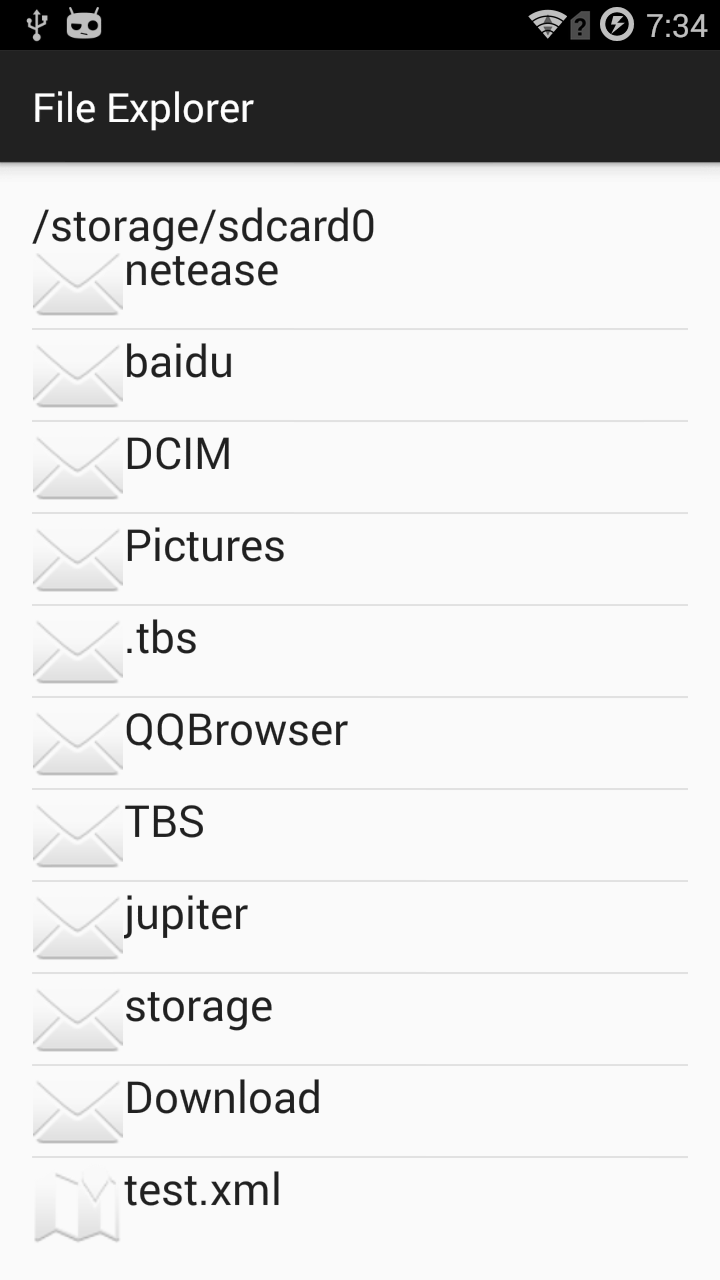Android开发手记(21) 遍历文件夹
我们在遍历文件夹的时候由于涉及到SD卡相关操作,所以我们需要添加如下权限:
<uses-permission android:name="android.permission.WRITE_EXTERNAL_STORAGE"/>
<uses-permission android:name="android.permission.MOUNT_UNMOUNT_FILESYSTEMS"/>
首先,需要检查SD卡挂载状态:
boolean sdCard = Environment.getExternalStorageState().equals(Environment.MEDIA_MOUNTED);
if (!sdCard) {
Toast.makeText(MainActivity.this, "SD卡未挂载", Toast.LENGTH_SHORT).show();
MainActivity.this.finish();
}
当getExternalStorageState()挂载状态返回为未挂载时,程序提示错误,并结束执行。
然后,通过Intent获取Activity当前的消息,如果第一次执行,那么Intent所get到的信息为空。此时就读取SD卡根目录文件列表。如果不是第一次执行,那么就获取上次传入的文件路径信息,然后再读取此文件路径下的文件列表。
Intent intent = getIntent();
CharSequence cs = intent.getCharSequenceExtra("filePath"); //filePath 为传入的文件路径信息
if (cs != null) {
File file = new File(cs.toString());
tvPath.setText(file.getPath());
files = file.listFiles();
} else {
File sdFile = Environment.getExternalStorageDirectory();
tvPath.setText(sdFile.getPath());
files = sdFile.listFiles();
}ra("filePath");
然后,在获取到了所有的文件列表信息之后,我们需要将其输入到ListView中,而ListView数据是和Adapter绑定的。Adapter的初始化原型为:
SimpleAdapter(Context context, List<? extends Map<String, ?>> data, int resource, String[] from, int[] to) // context 是上下文,这里我们取MainActivity.this // data 是数据来源,是一个Map结构,最终显示Map中的Value // resource 是资源文件,根据此xml文件将ListView中内容排版 // from 是数据来源的名称,为Map中的Key值 // to 是将数据和resource中进行绑定id的值
根据此,我们实例化一个Map来存储最终需要显示的数据,同时新建一个资源文件/res/layout/list_layout.xml来对ListView内容进行排版:
<?xml version="1.0" encoding="utf-8"?>
<LinearLayout xmlns:android="http://schemas.android.com/apk/res/android"
android:orientation="horizontal" android:layout_width="match_parent"
android:layout_height="match_parent"
android:weightSum="1">
<ImageView
android:layout_width="46dp"
android:layout_height="45dp"
android:id="@+id/image" />
<TextView
android:layout_width="wrap_content"
android:layout_height="38dp"
android:textAppearance="?android:attr/textAppearanceLarge"
android:text="Large Text"
android:id="@+id/fileName"
android:layout_weight="0.14" />
</LinearLayout>
List<HashMap<String, Object>> list = new ArrayList<>();
for (int i = 0; i < files.length; i++) {
HashMap<String, Object> hashMap = new HashMap<>();
if (files[i].isDirectory()) {
hashMap.put("image", android.R.drawable.ic_dialog_email);
} else {
hashMap.put("image", android.R.drawable.ic_dialog_map);
}
hashMap.put("fileName", files[i].getName());
list.add(hashMap);
}
最后,实例化此Adapter并将ListView与其绑定,同时为ListView添加Item单击事件。如果Item是目录的话,就将目录的路径通过intent传递给Activity,然后启动此Activity。回到起始定义Intent的地方,此Intent会得到由Activity传递过来的目录信息,然后根据此目录信息可以进一步访问文件目录。
SimpleAdapter adapter = new SimpleAdapter(MainActivity.this, list, R.layout.list_layout,
new String[]{"image", "fileName"}, new int[]{R.id.image, R.id.fileName});
listView.setAdapter(adapter);
listView.setOnItemClickListener(new AdapterView.OnItemClickListener() {
@Override
public void onItemClick(AdapterView<?> adapterView, View view, int i, long l) {
if (files[i].isDirectory()) {
File[] childFile = files[i].listFiles();
if (childFile != null && childFile.length >= 0) {
Intent intent = new Intent(MainActivity.this, MainActivity.class);
intent.putExtra("filePath", files[i].getPath());
Toast.makeText(MainActivity.this, files[i].getPath(), Toast.LENGTH_SHORT).show();
startActivity(intent);
}
}
}
});
完整代码如下:
import android.content.Intent;
import android.os.Environment;
import android.support.v7.app.AppCompatActivity;
import android.os.Bundle;
import android.view.View;
import android.widget.AdapterView;
import android.widget.ListView;
import android.widget.SimpleAdapter;
import android.widget.TextView;
import android.widget.Toast;
import java.io.File;
import java.util.ArrayList;
import java.util.HashMap;
import java.util.List;
public class MainActivity extends AppCompatActivity {
private TextView tvPath;
private ListView listView;
private File[] files;
@Override
protected void onCreate(Bundle savedInstanceState) {
super.onCreate(savedInstanceState);
setContentView(R.layout.activity_main);
tvPath = (TextView) findViewById(R.id.textView);
listView = (ListView) findViewById(R.id.listView);
boolean sdCard = Environment.getExternalStorageState().equals(Environment.MEDIA_MOUNTED);
if (!sdCard) {
Toast.makeText(MainActivity.this, "SD卡未挂载", Toast.LENGTH_SHORT).show();
MainActivity.this.finish();
}
Intent intent = getIntent();
CharSequence cs = intent.getCharSequenceExtra("filePath");
if (cs != null) {
File file = new File(cs.toString());
tvPath.setText(file.getPath());
files = file.listFiles();
} else {
File sdFile = Environment.getExternalStorageDirectory();
tvPath.setText(sdFile.getPath());
files = sdFile.listFiles();
}
List<HashMap<String, Object>> list = new ArrayList<>();
for (int i = 0; i < files.length; i++) {
HashMap<String, Object> hashMap = new HashMap<>();
if (files[i].isDirectory()) {
hashMap.put("image", android.R.drawable.ic_dialog_email);
} else {
hashMap.put("image", android.R.drawable.ic_dialog_map);
}
hashMap.put("fileName", files[i].getName());
list.add(hashMap);
}
SimpleAdapter adapter = new SimpleAdapter(MainActivity.this, list, R.layout.list_layout,
new String[]{"image", "fileName"}, new int[]{R.id.image, R.id.fileName});
listView.setAdapter(adapter);
listView.setOnItemClickListener(new AdapterView.OnItemClickListener() {
@Override
public void onItemClick(AdapterView<?> adapterView, View view, int i, long l) {
if (files[i].isDirectory()) {
File[] childFile = files[i].listFiles();
if (childFile != null && childFile.length >= 0) {
Intent intent = new Intent(MainActivity.this, MainActivity.class);
intent.putExtra("filePath", files[i].getPath());
Toast.makeText(MainActivity.this, files[i].getPath(), Toast.LENGTH_SHORT).show();
startActivity(intent);
}
}
}
});
}
}






